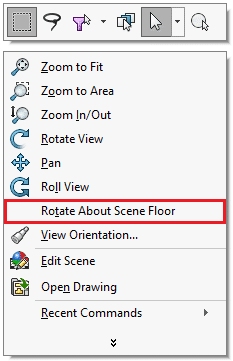Rotate About Scene Floor, AKA “Why does my Rotate cursor look different in SOLIDWORKS?”

I had unknowingly struggled with this SOLIDWORKS command for several months. I use “unknowingly” here not because I wasn’t aware that I was struggling (I very much was) but because I wasn’t aware that this command was the cause. I write this article in hopes that there are others out there in my former position—knowing the what but not the why.
Essentially, it seemed like SOLIDWORKS suddenly stopped letting me perform certain rotations. The model would get “stuck” in its Bottom or Top orientation. I could still roll (i.e., move clockwise or counterclockwise), but it was difficult to move away from that view in certain directions. The giveaway that something was off was the icon that appeared when rotating. Rather than the standard flat circle I was used to, I started getting a different arced arrow with a line running through it (see the image above). This is similar to the icon you see when rotating about an edge of the model, but I would see this even without preselecting any geometry. After (truly) a year of just passing this off as something messed up in my registry, I decided to try some more intensive searching and discovered the culprit: Rotate About Scene Floor.
Now that I know what it is, I can say that Rotate About Scene Floor is genuinely a very useful option. Introduced in SOLIDWORKS 2013, it constrains the rotation of a model, specifically preventing the vertical axis from “tilting” to the left or right. (The “vertical axis” is the Y-direction by default, but this can be changed, as I will demonstrate later on.) The easiest way to find this option is by right-clicking an empty space in the graphics area, as shown below. It acts like a System Option—once enabled, it will be active for all documents you open on that computer. Thus, my issue was likely that I turned it on one day without realizing it, unable to figure out afterward which option controlled the behavior.

Imagine that your model is on a glass tray floating in front of you. You can walk in a circle around the model, you can bend or crouch to see the model above or below the tray, but the tray must remain parallel with the floor. This is the impression you get when using Rotate About Scene Floor.
For a clearer explanation, take a look at the videos below. In the first clip, Rotate About Scene Floor is off. As a result, I can rotate the model all around the viewport; the Y-axis can move in any direction. For the second video, Rotate About Scene Floor is on. (You can tell it is enabled based on my cursor icon.) In this clip, the model starts to roll when I reach the Bottom or Top orientation because the program prevents the vertical direction from going off-axis: The Y-axis is able to move forwards and backwards, but it will not move left or right.


As I suggested earlier, it is possible to change what the “vertical axis” is in your model. SOLIDWORKS aligns this axis with the vertical direction in the model’s Front orientation, so by redefining the Front view you can redefine the axis. To do this, start by rotating the model into the orientation you want to become the Front view. Hit the Spacebar to bring up the Orientation dialog, and click on “Update Standard Views.” SOLIDWORKS prompts you to pick the target view from the listed orientations, so select the icon for the Front. SOLIDWORKS recreates the remaining views based on this new orientation. In the image below, what was my Top view is now my Front view, so the vertical axis is Z. With Rotate About Scene Floor active, the Z-axis will not tilt left or right, while X and Y can twist in all directions.


To those of you unfamiliar with the Rotate About Scene Floor setting, I hope this has given you an idea of how it might help you; and to those of you who, like me, have been inadvertently using it, I hope this has at least partially answered the eternal question of “Why is SOLIDWORKS doing this?” If you would like more information, either on this tool or on anything else in the software, feel free to reach out.
Anthony Sandri
Application Engineer
Computer Aided Technology, Inc.

 Blog
Blog